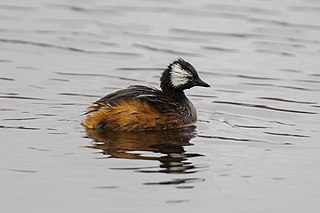
The common snipe is a small, stocky wader native to the Old World.

Wilson's snipe is a small, stocky shorebird. The genus name gallinago is New Latin for a woodcock or snipe from Latin gallina, "hen" and the suffix -ago, "resembling". The specific delicata is Latin for "dainty".

The jack snipe or jacksnipe is a small stocky wader. It is the smallest snipe, and the only member of the genus Lymnocryptes. Features such as its sternum make it quite distinct from other snipes or woodcocks.

The great snipe is a small stocky wader in the genus Gallinago. This bird's breeding habitat is marshes and wet meadows with short vegetation in north-eastern Europe, including north-western Russia. Great snipes are migratory, wintering in Africa. The European breeding population is in steep decline.

The ruddy-headed goose is a species of waterfowl in tribe Tadornini of subfamily Anserinae. It is found in Argentina, Chile, and the Falkland Islands.

The pin-tailed snipe or pintail snipe is a species of bird in the family Scolopacidae, the sandpipers.

The Pantanal snipe is a small, stocky wader found in South America.

The puna snipe is a small, stocky wader. It breeds in the Andes of northern Peru to northwestern Argentina and northern Chile. It is sometimes considered conspecific with the South American snipe.

Swinhoe's snipe,, also known as forest snipe or Chinese snipe, is a medium-sized, long-billed, migratory wader.

The African snipe also known as the Ethiopian snipe, is a small stocky wader. It breeds in eastern and southern Africa in wet mountain moorland and swamps at altitudes of 1,700–4,000 m (5,600–13,100 ft). When not breeding it disperses widely, including into coastal lowlands.

The Madagascar snipe is a small stocky wader. It breeds only in the humid eastern half of Madagascar, from sea-level up to 2,700 m, being more common above 700 m. It is non-migratory.

The solitary snipe is a small stocky wader. It is found in the Palearctic from northeast Iran to Japan and Korea.

The Jameson's snipe or Andean snipe is a small, stocky wader. It breeds in the Andes in Bolivia, Colombia, Ecuador, Peru and Venezuela. It appears to be entirely sedentary, with no evidence of migration.

The imperial snipe is a small stocky wader which breeds in the Andes. For a century it was known only from two specimens collected near Bogotá, Colombia, and was presumed extinct, but it was rediscovered in Peru in 1967 and Ecuador in 1988. It is not known if it is migratory.

The noble snipe is a small stocky wader. It breeds in the Andes of Colombia, Ecuador, Peru and Venezuela above or just below the treeline. It is entirely sedentary.

The giant snipe is a stocky wader. It breeds in South America. The nominate subspecies G. u. undulata occurs in two distinct areas, one in Colombia, and the other from Venezuela through Guyana, Suriname and French Guiana to extreme north-eastern Brazil. The southern subspecies G. u. gigantea is found in eastern Bolivia, eastern Paraguay and south-east Brazil, and probably also in Uruguay and north-eastern Argentina.

The dark-bellied cinclodes is a species of bird in the family Furnariidae. It is found in Argentina and Chile. Its natural habitats are rivers and rocky shores. The dark-bellied cinclodes is distributed in Chile from about Santiago southwards to Tierra del Fuego and in adjacent areas of extreme western Argentina. It is found near streams, lakes and marshlands from sea level up to 2,500 m. It has a bold white supercilium and throat.

The white-tufted grebe, also known as Rolland's grebe, is a species of grebe in the family Podicipedidae. Found in the southern half of South America, its natural habitat is freshwater lakes, ponds and sluggish streams.

The grey-breasted seedsnipe is a species of bird in the family Thinocoridae. It is found in Argentina, Bolivia, Chile, and Peru.

The Magellanic snipe is a small, stocky wader.






















